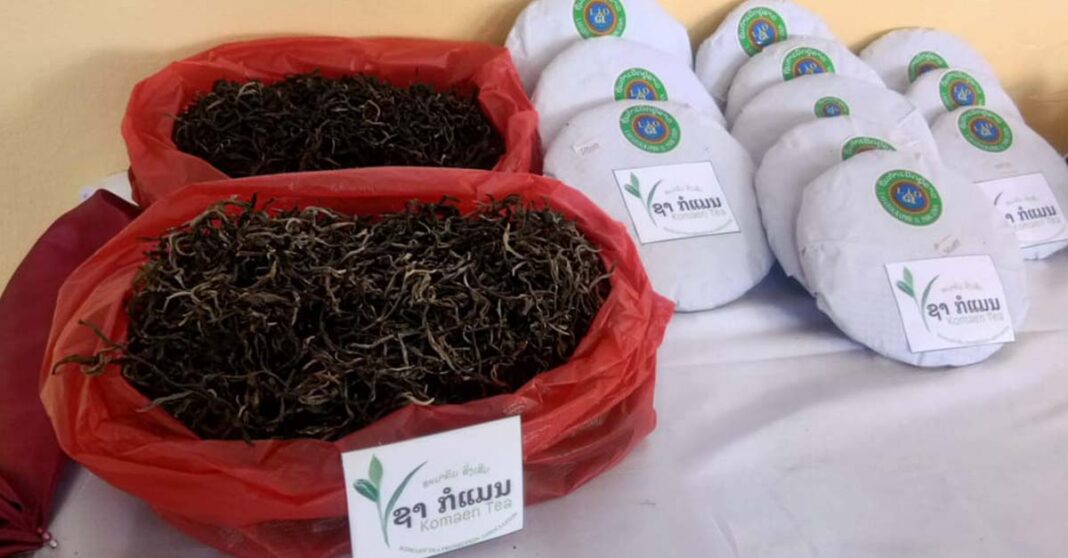In Laos like elsewhere, agricultural products have helped to embody the stories of the people that grow, harvest, preserve, prepare and cook them today using techniques honed over time. This is also the concept of geographical indications (GI) for products that are recognized for qualities linked to their origin.
A GI indicates quality food products or handicrafts as originating in a territory where a given quality and reputation or other unique characteristics of the goods linked to provenance, including raw materials or the methods of production used.
Khao Kai Noi Rice from Houaphan and Xieng Khouang provinces was the first product to receive a GI in Lao PDR. In 2020, the list of Lao GI was joined by Komaen tea (from Phongsaly province), as well as tea and coffee from Paksong (Champasak province) and silks from Luang Prabang and from Houaphanh provinces.

These products join famous names such as Champagne (France), Kampot Pepper (Cambodia), Kobe Beef (Japan), and Khao Hom Mali rice from Surin (Thailand).
Impressive accomplishments in the Lao PDR have been achieved in part as a result of a project for strengthening the Lao PDR’s national system for registering, controlling and protecting GIs.The project was funded by the Asian Development Bank (ADB) and implemented by the Food and Agriculture Organization of the United Nations (FAO), in collaboration with the Ministry of Science and Technology and the Ministry of Industry and Commerce.
These GIs can now benefit both producers and consumers. They bring together superior quality along with the preservation of biodiversity and traditional landscapes, local heritage, and production methods passed down over generations. This reputation typically translates into prices 20 to 50 percent higher than comparable non-GI products.
These Lao GI’s are already drawing interest and trade. Mr. Diem, a silk producer of the Luang Prabang Silk Promotion Association, has seen an increase of sales of about 67 percent despite the COVID-19 pandemic. Similarly, Mr. Senthong, a tea producer member of the Paksong Tea Promotion Association, confirms that the registration of tea as a GI has cemented their reputation and opened new market opportunities.
FAO Representative to Lao PDR Mr. Nasar Hayat said the project focused on strengthening the national legal framework and GI control systems. Most crucially, it supported the development and registration of four new GI products namely Komaen tea from Phongsaly, Paksong tea from Champasak and silk from Luang Prabang and from Houaphanh.
The event also marked recognition of the registration of two famous foreign GIs, in the form of Champagne and Scotch Whisky.
Mr. Nasar praised Lao’s GI registration efforts. “We felt very proud when the Lao Government submitted the Act of Accession to the Geneva Act of the Lisbon Agreement on Appellations of Origin and Geographical Indications, at the project’s last event on 20 November 2020. This international agreement will open up new opportunities for Lao GIs,” Mr. Nasar said.
FAO Regional Office for Asia and the Pacific-based economist and lead technical officer in charge of the project, Ms Eva Galvez concurred. “These GIs have been registered in record time, especially considering the additional challenges brought about by the COVID-19 pandemic. This success is due to the passion, knowledge, and dedication of all those involved: from the value chain actors to the project team and the national counterparts at central and provincial levels.”

Coordination was key to catalyzing support from development partners and government agencies to further strengthen value chains, and promote these products beyond the project completion, she said.
Support to the project from its commencement also came from an international GI expert, Mr. Stephane Passeri. It takes hard work and sustained effort to raise awareness, create associations representing the full value chain and build their capacities to manage and control the GIs, Mr. Passeri said.
He highlighted that now the concerned government agencies have the skills to promote GIs, assess registration requests, register GI products, and implement external control systems. A national GI Logo has also been created to improve the visibility of GI in the Lao market and abroad.
“I believe that the project has laid the foundations for many other qualifying products to be registered in Laos. The template is now available to all, and we expect to see more successful GI registrations very soon,” Mr. Passeri said.
Asia is the world’s most dynamic region for GI development after Europe. To date, nations in Asia have registered well over 10 000 GI products, predominantly from the food and agricultural sectors. In the region, China is at the forefront of this trend with over 8 000 registered GIs, followed by India with over 360, and Thailand and Viet Nam with more than a hundred GIs, among others.



